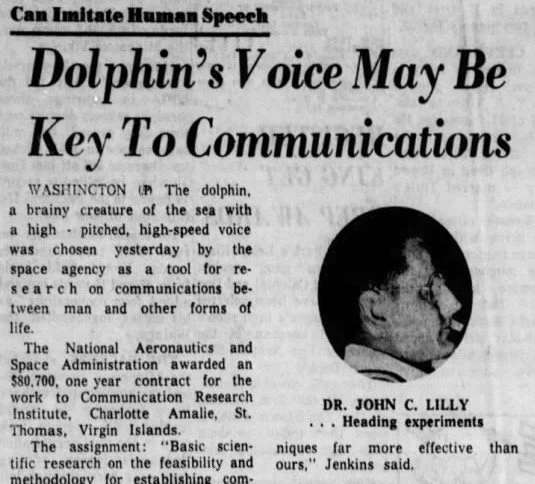1962: “Dolphin’s Voice May Be Key to Communications”
The Orlando Sentinel (September 17, 1962), no author attributed
The dolphin, a brainy creature of the sea with a high-pitched, high-speed voice was chosen yesterday by the space agency as a tool for research on communications between man and other forms of life.
The National Aeronautics and Space Administration awarded an $80,700, one year contract for the work to Communication Research Institute, Charlotte Amalie, St. Thomas, Virgin Islands.
The assignment: "Basic scientific research on the feasibility and methodology for establishing communication between man and other species."
Naturally, the space agency is interested in "other species" that may someday be found on distant planets.
The study will be directed by Dr. John C. Lilly, a noted authority on the dolphin, better known as the porpoise.
Dr. Dale W. Jenkins, chief of NASA's environmental biology programs, said Lilly probably will do most of the research at an aquarium at Coconut Grove, just south of Miami.
Jenkins said Lilly had determined that dolphins talk to each other, but at a rate eight times faster than that of human beings.
Dolphins also have a remarkable gift of mimicry of the sounds they hear.
Jenkins said that when a dolphin has been properly conditioned, the animal apparently tries to repeat the human words.
The replies are likely to come out as an unintelligible series of squeaks, squeals, quacks and blats.
However, Lilly has reported that a dolphin repeated such phrases as "three two three" in distinguishable terms even though it was in a high-pitched Donald Duck quack-like form.
Jenkins said that when the tapes were slowed down to half or quarter speed, however, Lilly found an unexpected factor.
The dolphin apparently had taken the human vocalization and compressed it as to time. By slowing it down and lowering the pitch, the dolphin's voice came back in clear repetition of the human words.
Jenkins said the replies were so distinct that when one of Lilly's assistants with a southern accent spoke to the dolphin, the accent remained discernible faithfully even to the southern drawl.
"This work may help us toward understanding of the communications of other organisms, some of which have communications techniques far more effective than ours," Jenkins said.
"NASA faces the problem of far off communications, of communicating over vast distances.
"We will be needing far more effective methods of communication as our far-reaching our information.
"We have not yet determined whether there are any communications directed at earth from outer space. If we do make contact, we will have to work out systems of understanding."
Jenkins said Lilly would employ computer techniques in analyses of dolphin communications.
The scientist also uses hydrophones and underwater loud speakers to facilitate continuous exchanges between human beings and dolphins in the same bodies of water.
The navy is interested in the dolphin speech and has "sonar" system of hunting for prey and has conducted experiments at Point Mugu, Calif. One of the sea-going mammals was taught to recognize such words as "ball," "hat," "ring," and "stick."
